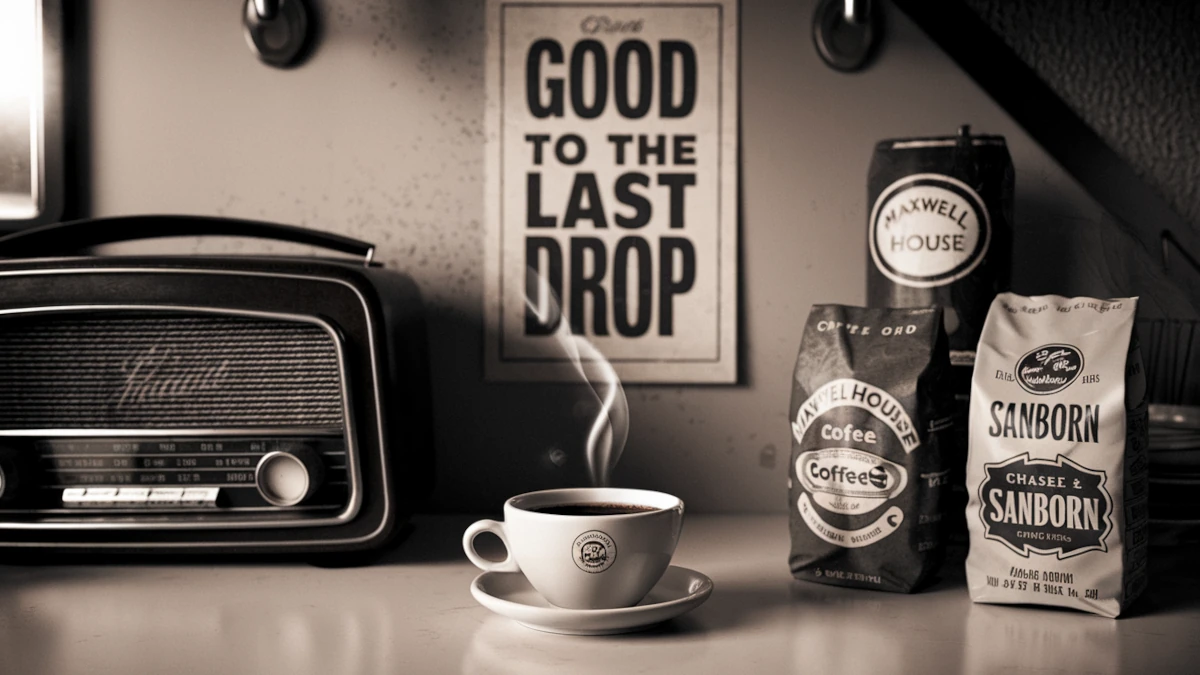The modern coffee break, an integral part of American work culture, has its roots in the mid-20th century. This practice was popularized by strategic campaigns such as the Pan-American Coffee Bureau’s famous slogan, “Give Yourself a Coffee Break.” But the tradition didn’t emerge by chance; it was shaped by a powerful intersection of advertising innovation and cultural evolution.
This article explores how the advertising of coffee influenced consumer habits, highlighted key brands, and left a lasting legacy in American culture.
Table of Contents
The Rise of Coffee Brands and Early Advertising
Early Coffee Branding
The late 19th and early 20th centuries witnessed the rise of iconic coffee brands like Maxwell House, Chase & Sanborn, and A&P. These companies leveraged innovative branding strategies to differentiate themselves in a growing market.
- Maxwell House became synonymous with quality, promoting its tagline “Good to the last drop.”
- Chase & Sanborn pioneered vacuum-sealed packaging, ensuring freshness.
- A&P marketed its coffee through its chain of grocery stores, creating direct consumer trust.
Leveraging Supermarket Shelf Space
As grocery chains expanded, shelf placement became a battlefield for coffee brands. Packaging played a crucial role, with bright colors, bold fonts, and clear labeling attracting buyers.
Key strategies:
- Eye-level placement to grab attention.
- Unique packaging designs to build brand identity.
- Discounts and in-store promotions to encourage repeat purchases.
These methods helped coffee brands secure their dominance and forge strong connections with consumers.
The Power of Mass Media in Coffee Advertising
From Print to Radio
Mass media opened new doors for coffee marketers to connect with a broad audience. Glossy magazine ads emphasized sophistication, associating coffee with upscale lifestyles.
Maxwell House’s radio variety show, The Maxwell House Show Boat, became a cultural phenomenon in the 1930s. It featured Hollywood stars sipping coffee, creating a powerful emotional appeal. This campaign boosted Maxwell House sales by 85% in its first year, demonstrating the influence of entertainment on brand loyalty.
Celebrity Endorsements and Emotional Appeals
Coffee advertisers capitalized on celebrity power to enhance credibility and desirability. Hollywood stars appeared in campaigns, connecting coffee with glamour and success.
At the same time, many ads tapped into consumer anxieties:
- Freshness campaigns: Hills Brothers emphasized their vacuum-packed coffee as the ultimate guarantee of quality.
- Social pressures: Ads targeted homemakers, suggesting that serving fresh coffee was a sign of care and competence.
Wartime Coffee Consumption and the Invention of the Coffee Break
Coffee as a Wartime Staple
During World War II, coffee became essential for soldiers. It boosted morale and helped troops stay alert during long missions. Military consumption far exceeded civilian levels, reinforcing coffee’s role as a daily necessity.
Post-war effects:
- Soldiers brought their coffee-drinking habits home.
- Coffee drinking became a symbol of normalcy and comfort in post-war America.
The Evolution of the Coffee Break
The concept of the coffee break originated from factory routines during the war but was cemented by the Pan-American Coffee Bureau’s 1952 campaign: “Give Yourself a Coffee Break.”
This groundbreaking advertising effort promoted coffee as a productivity booster. By the mid-1950s:
- Over 60% of American workplaces had implemented coffee breaks.
- The practice became a cultural staple, increasing coffee consumption nationwide.
Cultural Legacy of Coffee Advertising
Shaping American Daily Routines
Through relentless advertising, coffee became embedded in daily rituals:
- Breakfast companion: Coffee ads paired it with iconic American breakfasts.
- Workplace essential: The coffee break encouraged camaraderie and productivity.
- Social ritual: Ads linked coffee to family gatherings and casual chats.
The Global Impact of American Coffee Culture
The influence of American coffee advertising extended beyond borders. Brands like Maxwell House and Folgers inspired global markets to adopt similar consumption patterns, solidifying coffee as an international commodity.
Conclusion
The invention of the coffee break was more than a workplace innovation—it was a direct result of brilliant coffee advertising campaigns that reshaped consumer habits. By leveraging media, emotional appeals, and cultural trends, brands transformed coffee into an essential part of daily life.
Today, the legacy of these efforts lives on, not just in the advertising of coffee but also in its enduring role as a cultural and social cornerstone.
